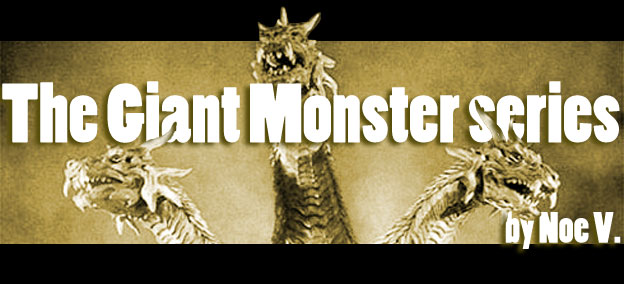
When I began this series I mentioned that the giant monsters in stories were created to entertain but also to help make sense out of chaos. They were created to help audiences face their own limitations and mortality. In the past century there have been tremendous natural disasters. Tidal waves, earthquakes, hurricanes and other phenomena that have caused the death of thousands of people. Centuries ago those events would have been attributed to an angry god, but today we know much more about the natural world than ever before. Yet there existed one thing that could never be predicted, the cruelty of man. The atomic bombs dropped at Hiroshima on August 5, 1945 and Nagasaki on August 9, 1945 at the end of World War II forever changed the psyche of the nation and planet.
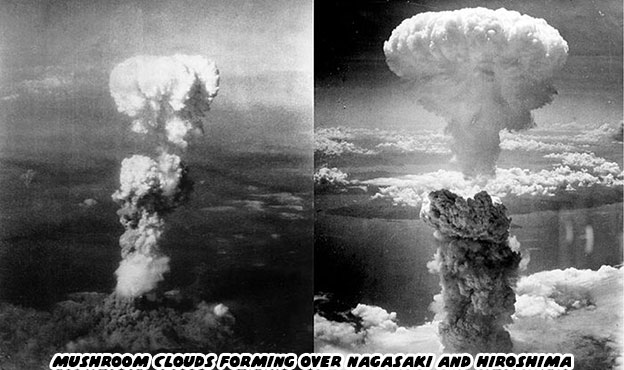
The fear, anger and loss experienced by the Japanese was incalculable. It extended beyond mass destruction and a never ending body count. The terror witnessed by survivors was infinitely worse than could be imagined by any horror writer. The flash generated by the bombs evaporated people near ground zero and burned their shadows into nearby buildings. The heat generated by the bombs was three times hotter than the surface of the sun, fuzing metals and ceramics together and burning out the eye sockets of those staring at the blast. Those that did not perish in the explosion died slow, lingering deaths from radiation burns and radiation poisoning. Hell on Earth was personified in the irradiated wasteland left by the US bombers. The Japanese that were neither for or against the war were trapped in the middle. They did not know that their cities were targeted instead of the military bases. They did not know that people in the West would ever retaliate in such a way after the bombing of Pearl Harbor. What the bombs did to the people, the psyche and world view may never be fully understood. The nation did rebuild, its infrastructure, its industries its business and education systems were restructured. The nation came back stronger through the '50s and '60s but perpetually haunted by the ghosts of the atomic age.
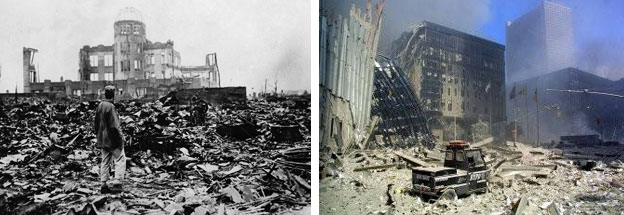
Something similar happened to the US on September 11, 2001. The hijacking of multiple planes and their use as weapons of mass destruction had never happened before on US soil. The nation used to have a completely different mindset before the collapse of the World Trade Center towers. To say that people in the US felt invulnerable would not be far from the truth. The loss of life, scope of the attacks and coordinated effort to topple a nation almost worked. The people were shocked. We were not in a war and had never known enemies of the nation that could strike at home. It seemed impossible but as the news poured in we could not escape the terrible truth. We were vulnerable, we could be hurt and we could be killed simply for being US citizens. Many lashed out with rage, others looked inward with blame. There was nothing that could make sense of this tragedy. Fear covered the psyche of the people like a weighted blanket. People woke, went to work or school with a heavy heart. Never knowing when the next strike against the nation would happen. The perpetual state of fear seemed to be part of the new daily routine. The uncertainty must have been similar to what people in Japan had felt after the bombs.
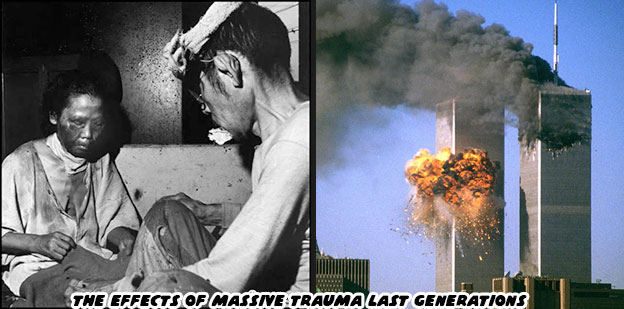
Living with fear and uncertainty on a daily basis must have been what our ancestors had struggled through since the dawn of time. Speaking about it seemed taboo yet almost every person must have felt like talking about it at some point. It was family, friendship, love and community that held them together. It was the stories of heroism in the face of adversity that motivated them. The villains in those stories were like the forces of nature, often gigantic, unstoppable and uncaring. Their modern equivalents were atomic weapons and planes-turned-into bombs. Broadcasting the pictures and film over and over had become the new taboo. People were already living in fear, why would they need to be haunted by images the mass destruction?
Something happened in 1954 that completely changed the psyche of millions. Gojira (Godzilla) debuted the same year as Them! the movie about giant radioactive ants however only one giant creature would be ingrained into global consciousness. Godzilla would be the measuring stick by which all other giant monsters would be judged. Godzilla was a horror movie unlike the giant monster movies in the west. The bipedal lizard was an unstoppable force that left nothing but mass destruction in its wake. It was a modern god of chaos, an engine of destruction with no equal. Tiny models crumbled and exploded under the weight of a man in a rubber suit, however the subtext was anything but campy. Japan was barely managing to survive the wrath of an atomic menace. They hit the creature with everything they had but did no discernible damage to it. In return they had to find a way to survive the onslaught. Their struggle was broadcast for the world to see.
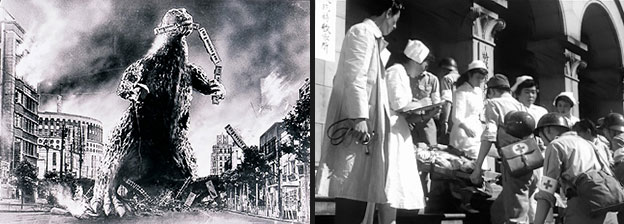
Looking back it was a very risky film to produce. Perhaps some things were too taboo to make screenplays on, then again perhaps some things needed to be dramatized in order to be explained and understood. Godzilla became a hit because it offered something that no other monster movie had before. Godzilla offered a cathartic experience for audiences. Specifically to those that lived in fear and those that lived with the guilt of surviving the horrors of war. The film worked on the same level as the ancient Greek tragedies. Audiences could see a tragedy unfold before them. They would become connected to the actor on the stage and feel as if they were a part of the loss but when they left they would also be relieved of that loss. The burden of survival that those in Hiroshima and Nagasaki bore was shared by a nation. Those that perished from the atomic monster did not die in vain. The nation was strong because it was made up of people that learned to adapt and face adversity with courage. They no longer had to live with fear because the menace that plagued them was only temporary. The monster that had terrorized them was like a force of nature, it did not care for the destruction it left behind, in fact it cared for nothing at all. Godzilla returned back to the ocean that spawned it almost as quickly as it arrived.
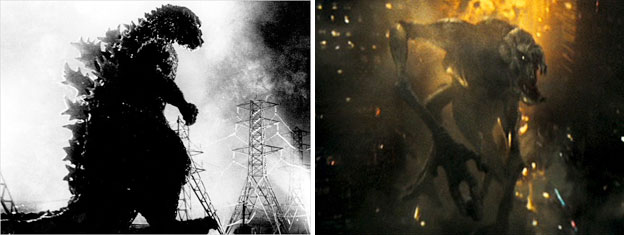
In 2008 the American Director JJ Abrams released Cloverfield. Audiences either loved the movie or hated it, mainly because of the filming style. Abrams used a point-of-view handheld camera throughout the movie in order to create a realistic feel. This gave a large number of patrons a sense of vertigo. I did not enjoy that style of "found" footage in the Blair Witch Project or Paranormal Activity yet for some reason I thought it worked well for Cloverfield. The unnamed monster seemed more menacing when it could only be captured in glimpses or filled out the frame even on distance shots. If helped create a sense of scale for the enormous beast. More important, the use of the format allowed for audiences to become more intimate with the main characters. When they died audiences felt a connection, especially with Hud the cameraman. The movie was an homage to Godzilla, only this time set in New York. The creature destroyed several landmarks and toppled a skyscraper similarly to the planes on September 11.
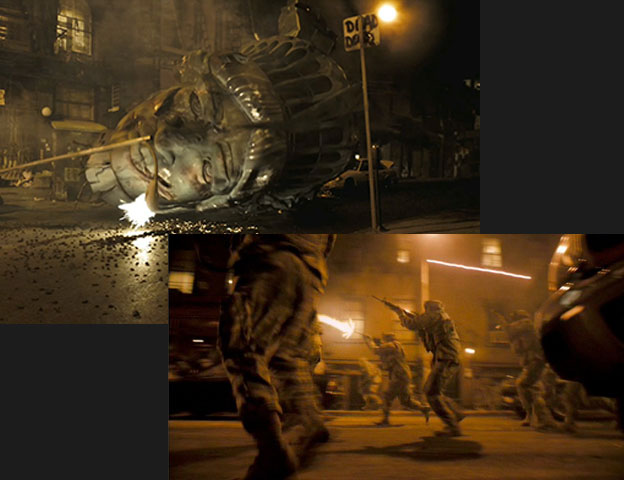
I felt nervous watching the scenes of destruction especially when the main characters were caught between the giant monster and military assaults. Nothing the Army did seemed to faze the creature. Just like the first Godzilla, people were simply powerless against it. At the end of the film I actually felt different. I felt as if something had changed in the core of my being. Audiences left their negative emotions behind when they saw a tragic play, I had the same feeling when I left the movie theater. The emotional reaction that Abrams was going for worked because he set his film in New York and he let audiences work out their own feelings of what would happen to them if they were caught in a situation like that. The knot that I had in my stomach from living day to day in fear of another terrorist attack had been undone. I walked away feeling changed. I knew that no matter what devastation I saw on the screen the real New York City was safe. More important I realized that the city had not stopped rebuilding since September 11.
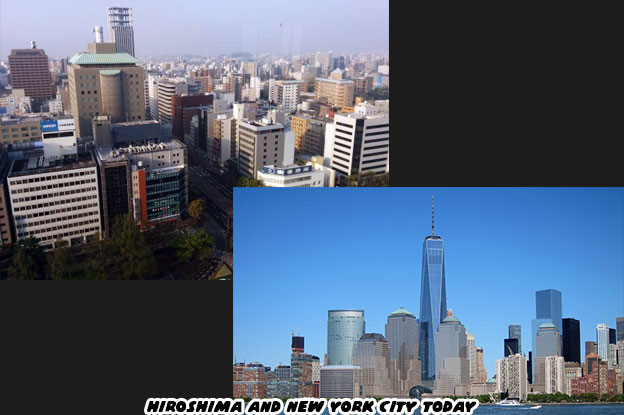
Location was part of the reason why Godzilla and Cloverfield worked but there was much more to the formula than that. Giant monsters were different from regular monsters. Regular movie monsters were emotive, sometimes cruel and calculating villains. Giant monsters were more like disasters than bad guys. Dracula, the Mummy, the Wolfman and Frankenstein's monster were monsters, or kaiju in Japanese. King Kong, Godzilla and the other enormous creatures were daikaiju, or giant monsters. A regular monster in most films had a weakness. Whether it was a stake through the heart, being dragged into the sunlight or shot with a silver bullet. Most movie monsters could be defeated through conventional weapons. Daikaiju were nearly indestructible and no weapon invented could kill them. In many films there were even enormous robots and other science fiction weapons created to try and stop the daikaiju. Perhaps armies could slow them down or contain them but they could never hope to kill a daikaiju with anything short of a nuclear strike.
Daikaiju stories worked on a different set of principles than traditional tales. In order for a daikaiju story or film to work the creator had to build an atmosphere that tapped into an emotional and psychological response. By making the creatures nearly indestructible the author could focus on creating relationships with the characters and the audience. It could draw viewers into the world they created and have them emote as the story progressed. The emotions explored by the best daikaiju stories worked at a primal level with audiences. Daikaiju became the new myths and gods, their mere presence tapped into the same fear of our ancestors. In cinema this was done through visual and also audio cues. What movie fan does not know what the roar of Godzilla sounds like? When Ifukube Akira composed the Godzilla theme he used a full brass section to underscore the unstoppable force that was heading toward Tokyo. The motif continually built tension and had a forward moving momentum. The music featured strong contrasts between the strings, woodwind and brass. They were continuously fighting each other for the theme. It was like the classic composers Mahler or Wagner had become movie composers. The music shaped the world for countless generations, just as the music featured in cartoons had exposed many a young child to classical compositions. The themes highlighted in Godzilla showed audiences that new compositions could sound just as amazing. The use of the theme helped frame even small scenes with great success. The coming-of-age film Always 2: Sunset on Third Street inserted a short Godzilla sequence which gave many moviegoers goosebumps.
The importance of a strong theme and a powerful roar were not lost on Cloverfield. Award-winning composer Michael Giacchino was born during the release of the greatest string of Godzilla features in the mid 60's. He wrote Roar, the theme of Cloverfield. The nearly ten minute song is beat-for-beat an homage to the Godzilla overture.
Daikaiju evolved with cinema. The giant creatures were not locked into one role but began assuming more important elements. Society dictated what they wanted to see in film and the daikaiju had a sort of renaissance through the '60s and '70s. The style of post WWII monster movies changed with the times and laid the foundation for the giant monsters of today. The genre rose and fell in popularity through the '80s and '90s, at some points it became very silly and campy but it never fell completely out of favor with audiences. By 2000 the genre had become so well recognized that it could be adapted to just about any format. Dreamworks combined the old Hollywood monster films and the daikaiju films of Japan into an animated comedy in 2009. Monsters vs Aliens was a nod at several classic characters while trying to make the monsters more contemporary. The directors created awe-inspiring set pieces. Enormous space ships and fights throughout the city of San Francisco, the type of which could only have come from a daikaiju story, to make the battles bigger than those from any other animated film.
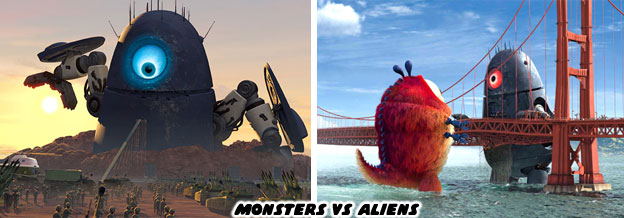
The spectacle of the gigantic battles and the exotic monster designs influenced several generations of artists, directors and now programmers. We shall look at how the genre changed from the 1960's to today, specifically what they contributed to video games in the next blog.
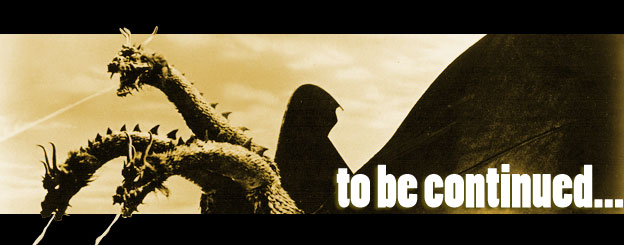
No comments:
Post a Comment